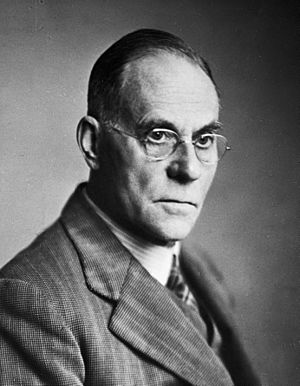Leonard Colebrook facts for kids
Quick facts for kids
Leonard Colebrook
|
|
|---|---|

Leonard Colebrook in 1945
By Walter Stoneman |
|
| Born | 2 March 1883 Guildford, Surrey, England
|
| Died | 27 September 1967 (aged 84) Farnham Common, Buckinghamshire, England
|
| Nationality | English |
| Alma mater | Royal London Hospital St Mary's Hospital, London |
| Known for | Prontosil |
| Awards | Fellow of the Royal Society (1945) FRCS FRCOG Blair Bell medal(1955) Edward Jenner Medal (1962) |
| Scientific career | |
| Fields | Medicine |
| Influences | Almroth Wright |
| Influenced | Peter Medawar |
Leonard Colebrook (born March 2, 1883 – died September 27, 1967) was an English doctor and scientist. He studied bacteria and made very important discoveries. His work helped save many lives, especially by finding ways to fight serious infections.
Contents
Early Life and Education
Leonard Colebrook was born in Guildford, England. He went to several schools when he was younger. Later, he began his medical training at the London Hospital Medical College. He then won a scholarship to St Mary's Hospital, London. He finished his medical studies in 1906.
A Career in Science
After finishing his studies, Colebrook stayed at St Mary's Hospital Medical School. From 1907 to 1914, he worked as an assistant to Sir Almroth Wright. He focused on treatments using vaccines and studied diseases like tuberculosis and pneumonia.
World War I Work
When World War I started, Colebrook joined the Royal Army Medical Corps. He was a captain and a medical officer. In 1917, he moved to France. There, he worked with Sir Almroth Wright again. They studied how to treat infections in soldiers' wounds.
Fighting Infections
After the war, Colebrook continued his research. He worked at the National Institute of Medical Research. In 1922, he returned to St Mary's Hospital. He became an expert in using chemicals to fight bacteria. He tried different compounds to treat infections. However, many of these were too strong for people.
A Breakthrough Discovery
In 1929, Colebrook became the director of a research lab. This lab was at Queen Charlotte's Hospital in London. He focused on a serious infection called puerperal sepsis. This infection happened after childbirth and killed many women.
In 1935, Colebrook made a huge discovery. He showed that a medicine called Prontosil could fight the bacteria that caused this infection. This was the first time an antibiotic was used in a clinical trial. His work dramatically reduced deaths from this infection. Before, about 1 in 4 women died. After his treatment, only 1 in 20 died.
Working with His Sister
Leonard's sister, Dora Colebrook, was also a bacteriologist. She worked at the same hospital. She helped investigate where the infections came from. They found that the bacteria causing the infection were common types. They often came from hospital staff, not just the patients.
Together, the Colebrooks pushed for better hygiene. They showed that doctors and nurses should wear gloves, masks, and gowns. They also proved that a disinfectant called chloroxylenol was better than soap and water for cleaning hands.
World War II and Burns Treatment
During World War II, Colebrook served as a colonel. He was a consultant for the British Army. He focused on treating infections in burns. In 1942, he moved to Glasgow. There, he directed a special unit for burns.
He also worked with Peter Medawar. Colebrook was interested in why skin grafts often failed. Medawar later discovered important things about how the body accepts or rejects new tissue. In 1944, Colebrook moved the Burns Unit to Birmingham Accident Hospital. He led it until he retired in 1948. He helped create a very clean environment for burn patients.
Promoting Safety
After he retired, Colebrook and his wife, Vera, worked on a new safety campaign. They wanted to make sure all portable electric heaters had guards. This would stop clothes from catching fire. Even though it was difficult, their efforts led to a new law in 1952. This law made fireguards a requirement. Their work also made people more interested in flame-proof clothing.
Personal Life
Leonard Colebrook was born into a large family. His father was a farmer and a preacher. In 1914, he married Dorothy Scarlett Campbell. She was a social worker. After she passed away, he married Vera Locke in 1946. He did not have any children. His favorite hobby was gardening. He died in 1967 at his home in Buckinghamshire.

